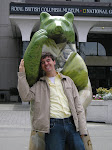If new and different music is what you seek, check out what Great Noise Ensemble is serving up. Their season closed last Friday with a performance of John Luther Adams' Clouds of Forgetting, Clouds of Unknowing. This took place at the UU Church of Silver Spring, which hosted GNE in 2009, and in 2006 for the memorable Steve Reich 70th birthday concert. It's really a great space to play and listen, and this evening was no exception.
Billed by the composer as creating "a small time and space for extraordinary listening," this 70-minute large chamber work was a bold and rather remarkable programming choice. John Luther Adams doesn't have the instant name recognition of Glass or (the other) Adams that would draw some in. And Clouds itself is a real endurance challenge for both performer and audience - but one that will repay your attention like few other compositions. The 19 movements progress from a prolonged unison to gradually larger intervals. Each section features contemplative figures that alternate, repeat, and build on each other. A few raucous bell-like movements provide some added surface activity, but it largely comes across as one gradual progression from small to large intervals.
After 70 solid minutes amid a sea of consonances and unobtrusive dissonances, the final movement closes in on the single most satisfying cadence I have ever experienced. Persistent sevenths resolve up into octaves - plain, vanilla, beautiful octaves. All imperfections finally removed, these reduce to a high unison on two violins then fade into silence.
Under the baton of conductor and artistic director Armando Bayolo, the performers played with impressive precision, tone, and endurance. The accompanying slideshow of Alaskan vistas, put together by the venue's music director Michael Holmes, had real distraction potential. Thankfully, the artfully chosen images and slow pace were a welcome complement.
This sort of music demands a different sort of attention - an elite listener, even - but it's an investment well worth your time. Such a meditate musical experience is rare, even in the option-filled marketplace that is new music.


No comments:
Post a Comment